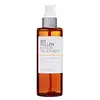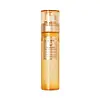What's inside
What's inside
 Key Ingredients
Key Ingredients

 Benefits
Benefits

 Concerns
Concerns

 Ingredients Side-by-side
Ingredients Side-by-side

Pollen Extract
EmollientGlycerin
HumectantGlycereth-26
HumectantWater
Skin Conditioning1,2-Hexanediol
Skin ConditioningButylene Glycol
HumectantNiacinamide
SmoothingPentylene Glycol
Skin ConditioningDiethoxyethyl Succinate
SolventBetaine
HumectantChondrus Crispus Extract
Skin ConditioningPEG-60 Hydrogenated Castor Oil
EmulsifyingSaccharum Officinarum Extract
MoisturisingPolyglyceryl-2 Oleate
EmulsifyingSodium Citrate
BufferingEthylhexylglycerin
Skin ConditioningAdenosine
Skin ConditioningDimethicone
EmollientHelianthus Annuus Seed Oil
EmollientLavandula Angustifolia Oil
MaskingDisodium EDTA
Glyceryl Glucoside
HumectantCitric Acid
BufferingAlcohol
AntimicrobialHydrogenated Lecithin
EmulsifyingPelargonium Graveolens Flower Oil
MaskingAnthemis Nobilis Flower Oil
MaskingCananga Odorata Flower Oil
MaskingCitrus Aurantium Bergamia Fruit Oil
MaskingRosa Damascena Flower Oil
MaskingRoyal Jelly Extract
Skin ConditioningLeontopodium Alpinum Callus Culture Extract
AntioxidantAspalathus Linearis Leaf Extract
Skin ConditioningPropanediol
SolventButyrospermum Parkii Butter
Skin ConditioningAnthemis Nobilis Flower Extract
MaskingHoney Extract
HumectantPhenethyl Alcohol
MaskingChrysanthemum Boreale Flower Extract
AntioxidantPropolis Extract
Skin ConditioningCaprylyl Glycol
EmollientSodium Hyaluronate
HumectantMaltodextrin
AbsorbentHydrolyzed Royal Jelly Protein
Skin ConditioningPollen Extract, Glycerin, Glycereth-26, Water, 1,2-Hexanediol, Butylene Glycol, Niacinamide, Pentylene Glycol, Diethoxyethyl Succinate, Betaine, Chondrus Crispus Extract, PEG-60 Hydrogenated Castor Oil, Saccharum Officinarum Extract, Polyglyceryl-2 Oleate, Sodium Citrate, Ethylhexylglycerin, Adenosine, Dimethicone, Helianthus Annuus Seed Oil, Lavandula Angustifolia Oil, Disodium EDTA, Glyceryl Glucoside, Citric Acid, Alcohol, Hydrogenated Lecithin, Pelargonium Graveolens Flower Oil, Anthemis Nobilis Flower Oil, Cananga Odorata Flower Oil, Citrus Aurantium Bergamia Fruit Oil, Rosa Damascena Flower Oil, Royal Jelly Extract, Leontopodium Alpinum Callus Culture Extract, Aspalathus Linearis Leaf Extract, Propanediol, Butyrospermum Parkii Butter, Anthemis Nobilis Flower Extract, Honey Extract, Phenethyl Alcohol, Chrysanthemum Boreale Flower Extract, Propolis Extract, Caprylyl Glycol, Sodium Hyaluronate, Maltodextrin, Hydrolyzed Royal Jelly Protein
Water
Skin ConditioningHydrogenated Poly(C6-14 Olefin)
EmollientDipropylene Glycol
HumectantCetyl Ethylhexanoate
EmollientNiacinamide
Smoothing1,2-Hexanediol
Skin ConditioningSodium Chloride
MaskingHoney
HumectantCurcuma Longa Root Extract
MaskingEthylhexylglycerin
Skin ConditioningCaprylyl/Capryl Glucoside
CleansingAdenosine
Skin ConditioningParfum
MaskingDisodium EDTA
Melia Azadirachta Flower Extract
Skin ConditioningGlycerin
HumectantButylene Glycol
HumectantAllantoin
Skin ConditioningMelia Azadirachta Leaf Extract
Skin ConditioningEclipta Prostrata Extract
Skin ConditioningEclipta Prostrata Leaf Extract
Skin ConditioningTocopheryl Acetate
AntioxidantMelia Azadirachta Bark Extract
AntimicrobialCorallina Officinalis Extract
Skin ConditioningLecithin
EmollientMoringa Oleifera Seed Oil
EmollientOcimum Sanctum Leaf Extract
Skin ConditioningBetaine
HumectantLysolecithin
EmulsifyingHydrolyzed Collagen
EmollientButyrospermum Parkii Butter
Skin ConditioningHydrogenated Lecithin
EmulsifyingPhenethyl Alcohol
MaskingMaltodextrin
AbsorbentHydrolyzed Royal Jelly Protein
Skin ConditioningWater, Hydrogenated Poly(C6-14 Olefin), Dipropylene Glycol, Cetyl Ethylhexanoate, Niacinamide, 1,2-Hexanediol, Sodium Chloride, Honey, Curcuma Longa Root Extract, Ethylhexylglycerin, Caprylyl/Capryl Glucoside, Adenosine, Parfum, Disodium EDTA, Melia Azadirachta Flower Extract, Glycerin, Butylene Glycol, Allantoin, Melia Azadirachta Leaf Extract, Eclipta Prostrata Extract, Eclipta Prostrata Leaf Extract, Tocopheryl Acetate, Melia Azadirachta Bark Extract, Corallina Officinalis Extract, Lecithin, Moringa Oleifera Seed Oil, Ocimum Sanctum Leaf Extract, Betaine, Lysolecithin, Hydrolyzed Collagen, Butyrospermum Parkii Butter, Hydrogenated Lecithin, Phenethyl Alcohol, Maltodextrin, Hydrolyzed Royal Jelly Protein
Ingredients Explained
These ingredients are found in both products.
Ingredients higher up in an ingredient list are typically present in a larger amount.
1,2-Hexanediol is a synthetic liquid and another multi-functional powerhouse.
It is a:
- Humectant, drawing moisture into the skin
- Emollient, helping to soften skin
- Solvent, dispersing and stabilizing formulas
- Preservative booster, enhancing the antimicrobial activity of other preservatives
Adenosine is in every living organism. It is one of four components in nucleic acids that helps store our DNA.
Adenosine has many benefits when used. These benefits include hydrating the skin, smoothing skin, and reducing wrinkles. Once applied, adenosine increases collagen production. It also helps with improving firmness and tissue repair.
Studies have found adenosine may also help with wound healing.
In skincare products, Adenosine is usually derived from yeast.
Learn more about AdenosineBetaine is a common humectant (a substance that promotes retention of moisture). It's known to be gentle on the skin and can help balance hydration.
This ingredient is best for improving hydration and soothing irritated skin. Studies also show it helps even out skin tone.
Fun fact: Betaine is naturally created in the skin and body. The kind found within cosmetic products can be either plant-derived or synthetic.
Another name for betaine is trimethylglycine.
Learn more about BetaineButylene Glycol (or BG) is used within cosmetic products for a few different reasons:
Overall, Butylene Glycol is a safe and well-rounded ingredient that works well with other ingredients.
Though this ingredient works well with most skin types, some people with sensitive skin may experience a reaction such as allergic rashes, closed comedones, or itchiness.
Learn more about Butylene GlycolThis ingredient is also known as shea butter. It is an effective skin hydrator and emollient.
Emollients help soothe and soften your skin. It does this by creating a protective film on your skin. This barrier helps trap moisture and keeps your skin hydrated. Emollients may be effective at treating dry or itchy skin.
Shea butter is rich in antioxidants. Antioxidants help fight free-radicals, or molecules that may harm the body. It is also full of fatty acids including stearic acid and linoleic acid. These acids help replenish the skin and keep skin moisturized.
While Shea Butter has an SPF rating of about 3-4, it is not a sunscreen replacement.
Shea butter may not be fungal acne safe. We recommend speaking with a professional if you have any concerns.
Learn more about Butyrospermum Parkii ButterDisodium EDTA plays a role in making products more stable by aiding other preservatives.
It is a chelating agent, meaning it neutralizes metal ions that may be found in a product.
Disodium EDTA is a salt of edetic acid and is found to be safe in cosmetic ingredients.
Learn more about Disodium EDTAEthylhexylglycerin (we can't pronounce this either) is commonly used as a preservative and skin softener. It is derived from glyceryl.
You might see Ethylhexylglycerin often paired with other preservatives such as phenoxyethanol. Ethylhexylglycerin has been found to increase the effectiveness of these other preservatives.
Glycerin is already naturally found in your skin. It helps moisturize and protect your skin.
A study from 2016 found glycerin to be more effective as a humectant than AHAs and hyaluronic acid.
As a humectant, it helps the skin stay hydrated by pulling moisture to your skin. The low molecular weight of glycerin allows it to pull moisture into the deeper layers of your skin.
Hydrated skin improves your skin barrier; Your skin barrier helps protect against irritants and bacteria.
Glycerin has also been found to have antimicrobial and antiviral properties. Due to these properties, glycerin is often used in wound and burn treatments.
In cosmetics, glycerin is usually derived from plants such as soybean or palm. However, it can also be sourced from animals, such as tallow or animal fat.
This ingredient is organic, colorless, odorless, and non-toxic.
Glycerin is the name for this ingredient in American English. British English uses Glycerol/Glycerine.
Learn more about GlycerinHydrogenated Lecithin is created from the hydrogenation of lecithin (a group of phospholipids). Hydrogenation is a chemical reaction between hydrogen and another element.
This ingredient is an emollient and emulsifier. As an emollient, it helps soften skin by trapping moisture within. As an emulsifier, it prevents oil and water ingredients from separating.
We don't have a description for Hydrolyzed Royal Jelly Protein yet.
Maltodextrin is a polysaccharide. It is derived from starch such as rice, corn, wheat, or potato starch.
In food, Maltodextrin is used to improve the texture and thicken a product. Due to its structure, it can help create a gel texture. As an emulsion stabilizer, it helps keep the ingredients in a product together.
As a polysaccharide, Maltodextrin has moisturizing properties. Polysaccharides are a type of carbohydrate. The top layer of skin uses polysaccharides to retain water, keeping the skin hydrated.
Maltodextrin is water soluble and has a sweet taste.
Learn more about MaltodextrinNiacinamide is a multitasking form of vitamin B3 that strengthens the skin barrier, reduces pores and dark spots, regulates oil, and improves signs of aging.
And the best part? It's gentle and well-tolerated by most skin types, including sensitive and reactive skin.
You might have heard of "niacin flush", or the reddening of skin that causes itchiness. Niacinamide has not been found to cause this.
In very rare cases, some individuals may not be able to tolerate niacinamide at all or experience an allergic reaction to it.
If you are experiencing flaking, irritation, and dryness with this ingredient, be sure to double check all your products as this ingredient can be found in all categories of skincare.
When incorporating niacinamide into your routine, look out for concentration amounts. Typically, 5% niacinamide provides benefits such as fading dark spots. However, if you have sensitive skin, it is better to begin with a smaller concentration.
When you apply niacinamide to your skin, your body converts it into nicotinamide adenine dinucleotide (NAD). NAD is an essential coenzyme that is already found in your cells as "fuel" and powers countless biological processes.
In your skin, NAD helps repair cell damage, produce new healthy cells, support collagen production, strengthen the skin barrier, and fight environmental stressors (like UV and pollution).
Our natural NAD levels start to decline with age, leading to slower skin repair, visible aging, and a weaker skin barrier. By providing your skin niacinamide, you're recharging your skin's NAD levels. This leads to stronger, healthier, and younger looking skin.
Another name for vitamin B3 is nicotinamide. This vitamin is water-soluble and our bodies don't store it. We obtain Vitamin B3 from either food or skincare. Meat, fish, wheat, yeast, and leafy greens contain vitamin B3.
The type of niacinamide used in skincare is synthetically created.
Learn more about NiacinamidePhenethyl Alcohol is a colorless and aromatic alohol. It is naturally occuring in essential oils.
The scent of this ingredient is floral and often compared to rose.
Like other alcohols, this ingredient helps prevent the growth of bacteria. However, its main purpose is to impact a fragrance.
Learn more about Phenethyl AlcoholWater. It's the most common cosmetic ingredient of all. You'll usually see it at the top of ingredient lists, meaning that it makes up the largest part of the product.
So why is it so popular? Water most often acts as a solvent - this means that it helps dissolve other ingredients into the formulation.
You'll also recognize water as that liquid we all need to stay alive. If you see this, drink a glass of water. Stay hydrated!
Learn more about Water